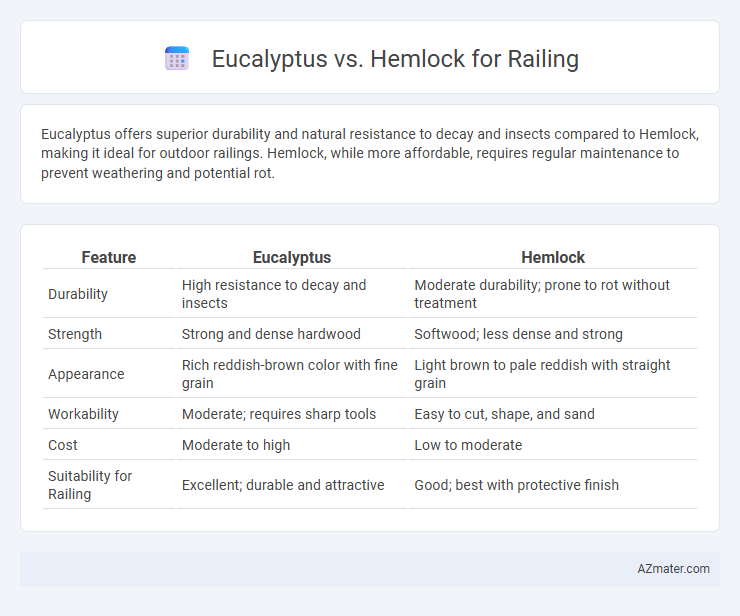Eucalyptus offers superior durability and natural resistance to decay and insects compared to Hemlock, making it ideal for outdoor railings. Hemlock, while more affordable, requires regular maintenance to prevent weathering and potential rot.
Table of Comparison
| Feature | Eucalyptus | Hemlock |
|---|---|---|
| Durability | High resistance to decay and insects | Moderate durability; prone to rot without treatment |
| Strength | Strong and dense hardwood | Softwood; less dense and strong |
| Appearance | Rich reddish-brown color with fine grain | Light brown to pale reddish with straight grain |
| Workability | Moderate; requires sharp tools | Easy to cut, shape, and sand |
| Cost | Moderate to high | Low to moderate |
| Suitability for Railing | Excellent; durable and attractive | Good; best with protective finish |
Introduction to Eucalyptus and Hemlock Wood
Eucalyptus wood is known for its high density, durability, and natural resistance to decay and insects, making it an excellent choice for outdoor railings exposed to varying weather conditions. Hemlock wood offers a lighter, more workable texture with moderate strength and good resistance to warping, suitable for indoor or sheltered railing applications. Both woods present distinct characteristics: Eucalyptus provides robust longevity and a rich reddish hue, while Hemlock features a pale, straight-grain appearance ideal for staining and painting.
Physical Properties Comparison
Eucalyptus offers high density and strength with Janka hardness ratings typically around 1,200 to 1,600 lbf, making it resistant to dents and wear, while Hemlock generally has a lower density and hardness near 560 lbf, resulting in a softer, less durable surface. Eucalyptus exhibits excellent dimensional stability and natural resistance to moisture and decay, suitable for outdoor railing installations, whereas Hemlock tends to absorb moisture more readily, leading to increased susceptibility to warping and rot without proper treatment. The higher tensile and compressive strength of Eucalyptus supports better load-bearing capacity for railings, contrasting with Hemlock's moderate strength levels which may limit its use in high-stress structural applications.
Durability and Longevity
Eucalyptus wood offers superior durability and resistance to decay compared to Hemlock, making it an excellent choice for railings exposed to outdoor elements. While Hemlock is lightweight and easy to work with, it lacks the natural oils and density that enhance Eucalyptus's longevity and resistance to moisture and pests. Eucalyptus typically outperforms Hemlock in maintaining structural integrity over time, especially in humid or variable weather conditions.
Resistance to Pests and Rot
Eucalyptus wood offers strong natural resistance to pests and rot due to its dense grain and high oil content, making it a durable choice for outdoor railing applications. Hemlock, on the other hand, has moderate resistance but requires proper treatment and maintenance to withstand insect attacks and fungal decay over time. Choosing eucalyptus can reduce the need for chemical preservatives, enhancing the longevity and low-maintenance performance of railings in pest-prone environments.
Aesthetic Differences
Eucalyptus railing offers a warm, reddish-brown hue with a fine, straight grain that enhances modern and rustic aesthetics, while Hemlock features a lighter, pale yellow tone with a more uniform texture suited for traditional and minimalist designs. The natural oils in Eucalyptus provide a subtle sheen and resistance to weathering, contributing to its rich, polished appearance over time. Hemlock's softer, matte finish allows for versatile staining and painting options, making it ideal for customizable railing styles.
Cost and Availability
Eucalyptus railing offers a cost-effective option with moderate pricing and widespread availability in many regions due to its fast growth and sustainable harvesting. Hemlock tends to be less expensive than traditional hardwoods but can be less available depending on local forestry resources, impacting overall project timelines. Both materials provide durable railing solutions, but eucalyptus's consistent supply and competitive cost make it a preferred choice in numerous construction projects.
Sustainability and Environmental Impact
Eucalyptus railing offers faster growth rates and higher carbon sequestration compared to Hemlock, making it a more sustainable choice for eco-conscious projects. Hemlock's slower growth and regional availability often result in less environmental disruption but lower renewability. Both woods require responsible sourcing certifications, such as FSC, to ensure minimal ecological impact throughout harvesting and processing.
Maintenance Requirements
Eucalyptus wood offers moderate maintenance requirements for railings, needing regular sealing or staining to prevent weathering and insect damage due to its natural oils. Hemlock railings require more frequent maintenance as the wood is softer and more susceptible to moisture absorption, necessitating consistent sealing and inspection for rot or decay. Both woods benefit from annual cleaning and protective finishes to ensure longevity and preserve aesthetic appeal in outdoor applications.
Best Applications for Railing Projects
Eucalyptus offers exceptional durability and natural resistance to moisture, making it ideal for outdoor railing projects exposed to weather elements. Hemlock provides a fine, uniform texture and stable strength, suitable for indoor railings or covered decks where appearance and smooth finish are priorities. Selecting eucalyptus for exterior railings ensures long-lasting performance, while hemlock is preferable for aesthetically refined, sheltered installations.
Choosing the Right Wood for Your Railing
Eucalyptus offers high durability and natural resistance to rot and insects, making it ideal for outdoor railings exposed to the elements, while Hemlock provides a lighter, more affordable option with good strength but less natural decay resistance. When choosing wood for your railing, consider eucalyptus for long-lasting, low-maintenance performance or hemlock if budget constraints and ease of customization are priorities. Proper sealing and maintenance are essential for both woods to ensure longevity and preserve aesthetic appeal.

Infographic: Eucalyptus vs Hemlock for Railing
 azmater.com
azmater.com